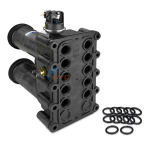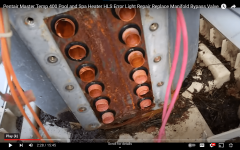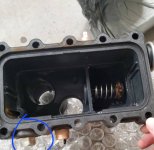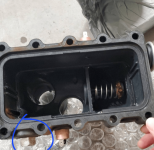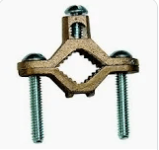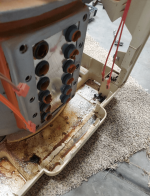Zinc Anode for Salt Water Pools, is that recommended?
- Thread starter Rockstead
- Start date
You are using an out of date browser. It may not display this or other websites correctly.
You should upgrade or use an alternative browser.
You should upgrade or use an alternative browser.
- May 23, 2015
- 24,542
- Pool Size
- 16000
- Surface
- Plaster
- Chlorine
- Salt Water Generator
- SWG Type
- Pentair Intellichlor IC-60
Moisture can build up behind the plastic manifold and the steel plate. That becomes a nice micro-environment for corrosion. My guess is the thickness of the steel plate used is to ensure that there is a long life - something else will eventually rot away before that steel plate does.
This is how I understood it.Yes. A hunk of zinc that is attached to or in contact with water but without a conductive pathway to close the circuit between itself another piece of metal in the water or the ground around it creates no galvanic couple. It’s essentially just a chunk of metal sitting water.
Therefore the zinc plug is useless as a sacrifical anode. It just floats inside the manifold housing.
Attachments
This looks like a chemistry problem.
Chemistry problems usually require a low pH and an oxidizer.
Low pH or oxidizer alone will usually not result in corrosion.
Low pH strips off the protective patina of copper oxide and this allows the oxidizers like chlorine and oxygen to attack the elemental copper.
Trichlor tabs are the most dangerous due to the low pH and the oxidizer combination.
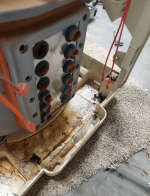
Chemistry problems usually require a low pH and an oxidizer.
Low pH or oxidizer alone will usually not result in corrosion.
Low pH strips off the protective patina of copper oxide and this allows the oxidizers like chlorine and oxygen to attack the elemental copper.
Trichlor tabs are the most dangerous due to the low pH and the oxidizer combination.

- May 23, 2015
- 24,542
- Pool Size
- 16000
- Surface
- Plaster
- Chlorine
- Salt Water Generator
- SWG Type
- Pentair Intellichlor IC-60
Water chemistry issues aside, here’s my take - given all the different metal components in contact with the water and cabinet, I would support the use of a local zinc anode like what Raypak has deployed (in-line Protek shield). I would make sure the zinc is connected to the bond wire and I would ensure that not only is the bond wire connected to the cabinet but that the heater tub has an electrical pathway between itself and the cabinet bond lug. In other words, the tub must be in the circuit path. The protek anode would need regular cleaning though to remove the build up of oxide scale.
This homeowner had an IC40. No tower.This looks like a chemistry problem.
Chemistry problems usually require a low pH and an oxidizer.
Low pH or oxidizer alone will usually not result in corrosion.
Low pH strips off the protective patina of copper oxide and this allows the oxidizers like chlorine and oxygen to attack the elemental copper.
Trichlor tabs are the most dangerous due to the low pH and the oxidizer combination.
I can't rule out the possibility their pool guy used tabs in the skimmer, but it seems unlikely.
Our tests at this home on the day of the diagnostic were 6 FC, 7.4 pH & 80 Alk. No idea what the trends were before that date. *We actually felt it wasn't chemistry and that it appeared to be electrolytic. This also tends to be more common with salt pools for obvious conductivity reasons. The exterior of the exchanger had been bathed in water for a long time. They indicated they'd had intermittent tripping of the gfci for months. This was the reason for the warranty call. Tub was not leaking in the least. Removing the ignitor showed it dipped in water. It had damaged the ignition module also, and we replaced it. Also replaced the bypass, T-reg and blower plate.
This repair was denied warranty but homeowner didn't trust their team any longer. We bid full rplc vs repair and they chose repair against our recommendation.
We don't love these jobs, but we make them worth the hassle.
*added context
Last edited:
A pH of 7.4 seems suspiciously low for a TA of 80.Our tests at this home on the day of the diagnostic were 6 FC, 7.4 pH & 80 Alk.
Maybe they are adding acid through the skimmers?
What is the CYA?
What did they do during the colder times when the SWG shut off?I can't rule out the possibility their pool guy used tabs in the skimmer, but it seems unlikely.
Do they have a tab feeder?
Maybe there is excessive water velocity?
Once the water velocity gets to about 6 feet per second for copper pipes, erosion begins to become a significant issue.
In my opinion, any flow over about 60 GPM is too much for a Mastertemp regardless of the manufacturer's allowance for higher flows.
Erosion increases exponentially like head loss.
So, if you double the flow, then erosion is at least 4 times as high.
What is the highest flow that the heater gets?
it appeared to be electrolytic.
Electrolysis is usually a DC issue and not AC.They indicated they'd had intermittent tripping of the gfci for months.
It's the same reason that you cannot use AC for a SWG cell because AC is not effective for electrolysis.
You can try to measure for a DC voltage gradient, but this can be very difficult if everything is bonded and grounded.
Bonding and grounding are intended to equalize differences of potential and this usually results in zero measured voltages or potential differences.
Tech tested using Taylor kit. He's not one to fudge. We trusted the read.A pH of 7.4 seems suspiciously low for a TA of 80.
Who knows. It has an autocover and some pool guys use the skimmers as dosage points more often on these.Maybe they are adding acid through the skimmers?
It didn't even register. Tech wrote 0. We weren't surprised given it was a salt system.What was the CYA?
Haven't a clue. But we know it was a rental and vacant for most of winter.What did they do during the colder times when the SWG shut off?
No.Do they have a tab feeder?
Maybe. This system was built 2021 and had a single speed.Maybe there is excessive water velocity?
Last edited:
Then our reps also have the languaging confused because this was the verdict back from Pentair after we submitted our report.Electrolysis is usually a DC issue and not AC.
Heat exchangers have to be sent for review/approval every time. It's never an item we have autonomy on designating.
Good point. We were focused on the tubes when we looked inside the ignitor hole and even more focused on them when we opened her up.The steel plate looks very clean.
If you had an electrolysis issue, I would expect the steel to be corroded as well.
Sorry. This was awhile ago and the old exchanger was scrapped.Can you cut through the heat exchanger in several spots to show how the copper looks inside the exchanger?
It has an autocover
It can be very easy for a pool with an autocover to get excessively high chlorine levels when using an SWG.It didn't even register. Tech wrote 0.
With no losses and a continuous addition of chlorine, the FC can get in the 50 to 100 ppm range very easily unless you are extremely careful to manage the FC.
With zero CYA, an FC of 50 to 100 will be very damaging.
A pH of 7.4 seems suspiciously low for a TA of 80.
My point is that the pH would not naturally be at 7.4 with a TA of 80, so something is suspicious about why the pH is at 7.4.Tech tested using Taylor kit. He's not one to fudge. We trusted the read.
Also, if the FC was too high, then the pH reads higher than actual and the pH might have been very low for an extended period.
What HP?This system was built 2021 and had a single speed.
Sure. I have no way of knowing if that happened previously. Only know what we tested that first day, which amounted to a surprise inspection of his work during a vacant streak. Granted the water was cold so cell was off. Didn't ask client how long it had been cold.It can be very easy for a pool with an autocover to get excessively high chlorine levels when using an SWG.
With no losses and a continuous addition of chlorine, the FC can get in the 50 to 100 ppm range very easily unless you are extremely careful to manage the FC.
With zero CYA, an FC of 50 to 100 will be very damaging.
Part of the problem is that the chemistry when you test it tells you nothing about the history.
The FC might have been 100 ppm and the pH might have been 4.0 at some point.
FC can be dropped quickly with various neutralizers and the pH can be brought up from 4.0 to 7.4 quickly.
Even if you asked the service people for the records, it is unlikely that they would give you accurate numbers.
The FC might have been 100 ppm and the pH might have been 4.0 at some point.
FC can be dropped quickly with various neutralizers and the pH can be brought up from 4.0 to 7.4 quickly.
Even if you asked the service people for the records, it is unlikely that they would give you accurate numbers.
I don't know. We were dispatched for the heater.What HP?
Yessir. As you can imagine, the homeowner was upset and felt like Pentair hung him to dry. We sympathized and explained how there are too many variables and he should find a team that keeps records.Part of the problem is that the chemistry when you test it tells you nothing about the history.
The FC might have been 100 ppm and the pH might have been 4.0 at some point.
FC can be dropped quickly with various neutralizers and the pH can be brought up from 4.0 to 7.4 quickly.
Even if you asked the service people for the records, it is unlikely that they would give you accurate numbers.
We always want to, but don't, offer our maintenance services in these situations. We are very careful not to do that during warranty calls. Had he used us, we would have heavy documentation of every stop ever made. We've invested heavily into software for our routes. Not to shift gears, but we specialize in STR water care as well, and we have to be extreme with documentation. These records have been used in arbitration more than once. It's wonderful living in a litigious society.
Last edited:
- May 23, 2015
- 24,542
- Pool Size
- 16000
- Surface
- Plaster
- Chlorine
- Salt Water Generator
- SWG Type
- Pentair Intellichlor IC-60
Yeah … looking at those tubes and how badly corroded they are I would say that is a combination of chemical and mechanical etching. Wouldn’t surprise me at all if the pool service was throwing pucks in the skimmer. It’s almost universally done as a standard practice. Add baking soda to the pool to keep the TA up, throw three pucks in the skimmer basket and come back 10 days later. That’s how it’s done around here. The bulk pool water doesn’t matter at all, if you put trichlor in the skimmer you are blasting the equipment with acidic and highly oxidizing water the second the pump kicks in. And if the pump speed is excessive, the copper pipe will just wear down.
Thread Status
Hello , This thread has been inactive for over 60 days. New postings here are unlikely to be seen or responded to by other members. For better visibility, consider Starting A New Thread.


